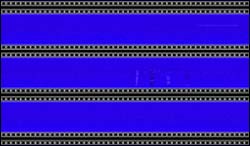New system ’sees’ crimes on audiotape

The NIST real-time audiotape imaging system reveals where a write head (taping event) stopped as a series of smudges or streaks on a film strip. (See faint smudge on center blue line.)
The Department of Commerce’s National Institute of Standards and Technology (NIST) has developed a real-time magnetic imaging system that enables criminal investigators to “see” signs of tampering in audiotapes—erasing, overdubbing and other alterations—while listening to the tapes. The new system,which permits faster screening and more accurate audiotape analysis than currently possible, recently was delivered to the Federal Bureau of Investigation (FBI) and will be evaluated for its possible routine use in criminal investigations. The FBI’s Forensic Audio Analysis Unit receives hundreds of audiotapes annually for analysis. Representing evidence from crimes such as terrorism, homicide and fraud, these tapes come from a wide variety of devices, including answering machines, cassette recorders and digital audiotape (DAT) recorders. The need for quick and accurate tape analysis is just as diverse: determining authenticity, comparing voices and identifying duplication are just a few examples.
At the heart of the NIST technology is a cassette player modified with an array of 64 customized magnetic sensors that detects and maps the microscopic magnetic fields on audiotapes as they are played. The array is connected to a desktop computer programmed to convert the magnetic data into a displayable image. Authentic, original tapes produce images with non-interrupted, predictable patterns, while erase and record functions produce characteristic “smudges” in an image that correlate to “pops” and “thumps” in the audio signal.
Additionally, copies of tapes lack the original markings specific to different types of tape players. Therefore, an examiner can use the new system to help determine the authenticity of a tape or if that tape is a copy. “We are the first to implement real-time magnetic imaging of audiotapes, and now, users can listen to the tape at the same time,” says project leader David Pappas of NIST’s Boulder, Colo., laboratories.
The benefits of the NIST system are its speed in correlating sounds with magnetic marks on tape and the fact that it makes an image without damaging the tape. Currently, the most common technique involves listening to a tape and stopping it when a suspicious sound is heard. The cassette then must be removed from the player, the tape extracted from its housing and a solution of magnetically sensitive fluid applied to the tape surface. Finally, the image of the audio track containing the suspicious sound is viewed under a microscope to determine whether or not an actual tampering event occurred. This is time consuming and subject to errors caused by particle contamination when applied to digital tapes.
For the new system, NIST scientists fabricated a 64-sensor linear array read head and placed it next to the standard read head in a commercial audiotape deck. The customized sensor array can scan a 4-millimeter-wide tape. Each sensor in the array changes its electrical resistance in response to magnetic fields detected from the tape. Software converts the sensor resistance measurements to visual images, which have a resolution of about 400 dots per square inch (dpi). A second-generation audiotape imaging system is under development, which is expected to provide ultrahigh image resolution of 1,600 dpi. That system will use 256 microscale sensors designed by NIST.
The basic magnetic imaging technology was developed in the late 1990s in a NIST collaboration with the Commerce Department’s National Telecommunications and Information Administration to retrieve data from damaged or altered magnetic tapes and computer disks. The researchers first demonstrated the approach by recovering data from scraps of aircraft “black-box” tape that were too short to be played in a conventional tape deck.
For several years, the FBI has been using a prototype of the NIST magnetic imaging system that scans samples with a single sensor many times to build up an image. Because the system is slow, it has been used only for testing and special cases. For example, the FBI used the technique on test tapes in a National Archives and Records Administration study on the feasibility of recovering audio from the famous 18-and-one-half minute gap in the Nixon White House “Watergate” tapes. Although intelligible speech could not be recovered from the test tapes, it was possible to distinguish between two types of erased tapes: one that had previously been recorded with audio and one that had not.
NIST and the FBI funded development of the latest, real-time audiotape imaging system.
As a non-regulatory agency of the U.S. Department of Commerce’s Technology Administration, NIST develops and promotes measurement, standards and technology to enhance productivity, facilitate trade and improve the quality of life.
Media Contact
More Information:
http://www.nist.govAll latest news from the category: Information Technology
Here you can find a summary of innovations in the fields of information and data processing and up-to-date developments on IT equipment and hardware.
This area covers topics such as IT services, IT architectures, IT management and telecommunications.
Newest articles

Properties of new materials for microchips
… can now be measured well. Reseachers of Delft University of Technology demonstrated measuring performance properties of ultrathin silicon membranes. Making ever smaller and more powerful chips requires new ultrathin…

Floating solar’s potential
… to support sustainable development by addressing climate, water, and energy goals holistically. A new study published this week in Nature Energy raises the potential for floating solar photovoltaics (FPV)…

Skyrmions move at record speeds
… a step towards the computing of the future. An international research team led by scientists from the CNRS1 has discovered that the magnetic nanobubbles2 known as skyrmions can be…





















